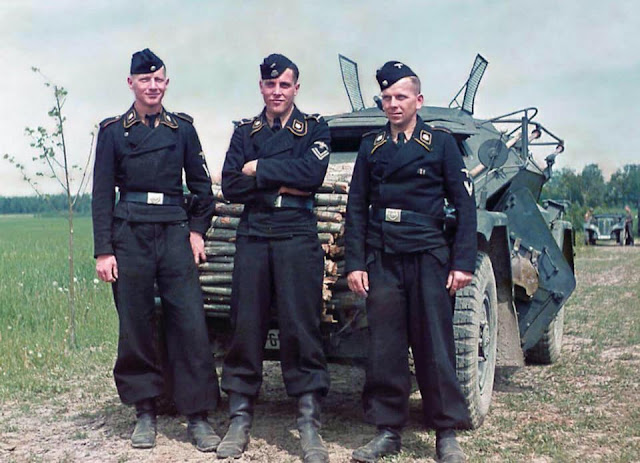These
pictures shows award ceremony of 11. Panzer-Division during Unternehmen
Barbarossa, summer of 1941. The recipients received Eisernes Kreuz
I.Klasse and Kriegsverdienstkreuz II.Klasse mit Schwertern.
Generalmajor Ludwig Crüwell (Kommandeur 11. Panzer-Division).
Generalmajor Ludwig Crüwell (Kommandeur 11. Panzer-Division) with his officers.
Generalmajor Ludwig Crüwell (Kommandeur 11. Panzer-Division) gives the award to his soldiers.
Generalmajor
Ludwig Crüwell (Kommandeur 11. Panzer-Division) with all of the
recipients in an award ceremony of the division. 6th from left (wearing
sidecap) is Oberstleutnant Gustav-Adolf Riebel (Kommandeur
Panzer-Regiment 15 / 11.Panzer-Division)
Generalmajor
Ludwig Crüwell (Kommandeur 11. Panzer-Division) speaking in front of
the member of his division. At right wearing black Panzer uniform is
Oberstleutnant Gustav-Adolf Riebel (Kommandeur Panzer-Regiment 15 /
11.Panzer-Division)
Four
new recipients of the Eisernes Kreuz I.Klasse (left) and
Kriegsverdienstkreuz II.Klasse mit Schwertern. Wearing black Panzer
uniform at far right is Oberstleutnant Gustav-Adolf Riebel
(Kommandeur Panzer-Regiment 15 / 11.Panzer-Division).
Generalmajor Ludwig Crüwell (left, Kommandeur 11. Panzer-Division) with one of his officer.
A
new recipient of Eisernes Kreuz II.Klasse from 11. Panzer-Division. He
is already sported SA-Treffen Braunschweig 1931 Badge and
SA-Sportabzeichen in his uniform.
The
new recipient of Eisernes Kreuz II.Klasse from 11. Panzer-Division
(which also a member of Sturmabteilung if you look at his SA-Treffen
Braunschweig 1931 Badge and
SA-Sportabzeichen in his uniform) chats with an officer from
Sonderführer Z (left)
Other new recipients of Eisernes Kreuz II.Klasse from 11. Panzer-Division
Source :
https://www.facebook.com/photo.php?fbid=298632194738945&set=pcb.1505028533015898&type=3&theater&ifg=1



























